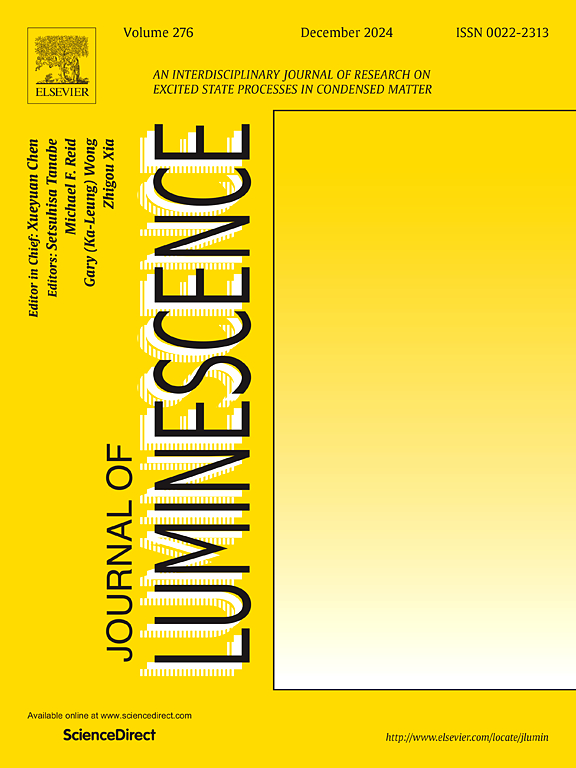微波辅助合成ZnS:Mn厚膜器件的电致发光研究
IF 3.3
3区 物理与天体物理
Q2 OPTICS
引用次数: 0
摘要
电致发光器件是现代照明和显示技术的重要组成部分,提供均匀和高效的光发射。该领域的研究主要集中在优化发光材料,如锰掺杂硫化锌(ZnS:Mn),其明亮的发射和环境兼容性备受赞誉。然而,目前的合成方法往往存在加工时间长、粒度控制差、相不稳定等问题,限制了这些材料的性能和可扩展性。在这里,我们展示了微波辅助溶剂热合成,然后是烧结步骤,可以生产出适合制造高效交流粉末电致发光(ACPEL)面板的高质量ZnS:Mn颗粒。通过x射线衍射证实,使用这种方法,ZnS:Mn颗粒主要形成稳定的晶相,烧结后出现二次相。光致发光测量显示出强烈的橙黄色发射,表明有效的Mn2+掺入。用这些粒子制成的ACPEL面板具有最佳性能,具有薄的电致发光膜,在中等激发条件下实现峰值发光。这些发现表明,改进的合成方法提供了均匀的颗粒形态,增强的发光性能和可靠的器件性能。这些结果通过提供可扩展和节能的路线来生产高性能电致发光材料,为改进照明和显示应用铺平了道路,从而推动了该领域的发展。直接影响包括在商用ACPEL系统中实现更一致的制造工艺和延长设备寿命的潜力。本文章由计算机程序翻译,如有差异,请以英文原文为准。
Electroluminescence in thick-film devices with ZnS:Mn prepared by microwave-assisted synthesis
Electroluminescent devices are essential components in modern lighting and display technologies, offering uniform and efficient light emission. Research in this field has focused on optimizing luminescent materials such as manganese-doped zinc sulphide (ZnS:Mn), which is prized for its bright emission and environmental compatibility. However, current synthesis methods often struggle with long processing times, poor control over particle size, and phase instability, limiting the performance and scalability of these materials. Here we show that microwave-assisted solvothermal synthesis, followed by a sintering step, enables the production of high-quality ZnS:Mn particles suitable for fabricating efficient alternating current powder electroluminescent (ACPEL) panels. Using this approach, the ZnS:Mn particles predominantly form in a stable crystalline phase with a secondary phase emerging after sintering, as confirmed by X-ray diffraction. Photoluminescence measurements reveal a strong orange-yellow emission, indicating effective Mn2+ incorporation. ACPEL panels fabricated with these particles exhibit optimal performance with a thin electroluminescent film, achieving peak luminescence under moderate excitation conditions. These findings demonstrate that the refined synthesis method provides uniform particle morphology, enhanced luminescent properties, and reliable device performance. These results advance the field by offering a scalable and energy-efficient route to produce high-performance electroluminescent materials, paving the way for improved lighting and display applications. Immediate implications include the potential for more consistent manufacturing processes and enhanced device longevity in commercial ACPEL systems.
求助全文
通过发布文献求助,成功后即可免费获取论文全文。
去求助
来源期刊

Journal of Luminescence
物理-光学
CiteScore
6.70
自引率
13.90%
发文量
850
审稿时长
3.8 months
期刊介绍:
The purpose of the Journal of Luminescence is to provide a means of communication between scientists in different disciplines who share a common interest in the electronic excited states of molecular, ionic and covalent systems, whether crystalline, amorphous, or liquid.
We invite original papers and reviews on such subjects as: exciton and polariton dynamics, dynamics of localized excited states, energy and charge transport in ordered and disordered systems, radiative and non-radiative recombination, relaxation processes, vibronic interactions in electronic excited states, photochemistry in condensed systems, excited state resonance, double resonance, spin dynamics, selective excitation spectroscopy, hole burning, coherent processes in excited states, (e.g. coherent optical transients, photon echoes, transient gratings), multiphoton processes, optical bistability, photochromism, and new techniques for the study of excited states. This list is not intended to be exhaustive. Papers in the traditional areas of optical spectroscopy (absorption, MCD, luminescence, Raman scattering) are welcome. Papers on applications (phosphors, scintillators, electro- and cathodo-luminescence, radiography, bioimaging, solar energy, energy conversion, etc.) are also welcome if they present results of scientific, rather than only technological interest. However, papers containing purely theoretical results, not related to phenomena in the excited states, as well as papers using luminescence spectroscopy to perform routine analytical chemistry or biochemistry procedures, are outside the scope of the journal. Some exceptions will be possible at the discretion of the editors.
 求助内容:
求助内容: 应助结果提醒方式:
应助结果提醒方式:


